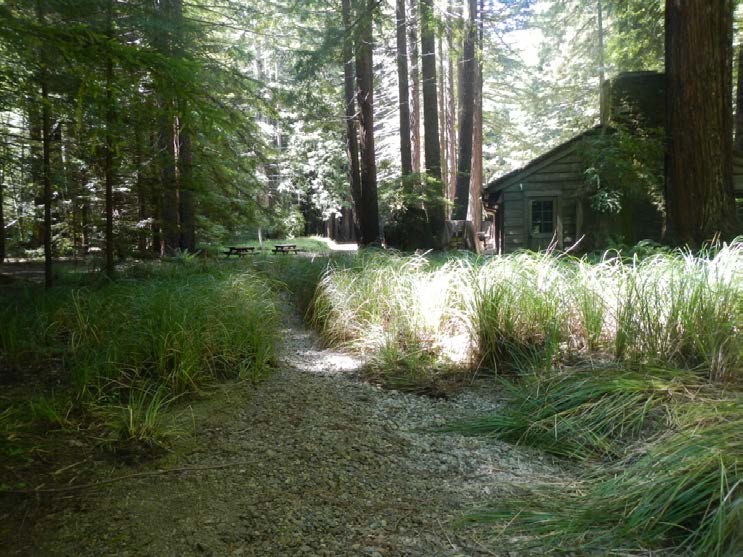
Purpose of the Project: The project restored access for coho salmon and steelhead trout to an estimated 4,000 feet of potential spawning and rearing habitat in the upstream reaches of Manly Gulch, a tributary to the Little North Fork of the Big River, that was previously flowing through Camp 3 and a parking lot. Camp 3 was part of the New Deal, constructed in the 1930s by the WPA and the CCC – it was conceived as a place to introduce people to the world of nature. Annually, juvenile coho and steelhead were observed stranded in drying pools in the aggraded reaches and in the road ditch that conveys Manly Gulch into Rocky Gulch. These conditions allowed the project area to be classified as a RED (100%) barrier for both adult and juvenile salmonid ingress and egress to and from Manly Gulch. The specific objective consisted of restoration and realigning 600 feet of Manly Gulch to connect directly to the LNF of the Big River. This included a 70-foot long backwater alcove and 530 feet of large-wood controlled channel with gravel riffles, pools and large wood cover structure. The project also included installation of a new bridge crossing over Manly Gulch where it crosses State Park Road. The direct connection between Manly Gulch to the LNF Big also improved both flow conveyance and sediment transport continuity within Manly Gulch from upstream of the project area to the LNF Big, thus improving fisheries access and habitat, geomorphic function, and reducing risk of fish stranding. The project also provided off-channel high-flow refugia for juvenile salmonids during elevated flows in the Little North Fork of the Big River.
Purpose of the Project:
The project restored access for coho salmon and steelhead trout to an estimated 4,000 feet of potential spawning and rearing habitat in the upstream reaches of Manly Gulch, a tributary to the Little North Fork of the Big River, that was previously flowing through Camp 3 and a parking lot. Camp 3 was part of the New Deal, constructed in the 1930s by the WPA and the CCC – it was conceived as a place to introduce people to the world of nature. Annually, juvenile coho and steelhead were observed stranded in drying pools in the aggraded reaches and in the road ditch that conveys Manly Gulch into Rocky Gulch. These conditions allowed the project area to be classified as a RED (100%) barrier for both adult and juvenile salmonid ingress and egress to and from Manly Gulch. The specific objective consisted of restoration and realigning 600 feet of Manly Gulch to connect directly to the LNF of the Big River. This included a 70-foot long backwater alcove and 530 feet of large-wood controlled channel with gravel riffles, pools and large wood cover structure. The project also included installation of a new bridge crossing over Manly Gulch where it crosses State Park Road. The direct connection between Manly Gulch to the LNF Big also improved both flow conveyance and sediment transport continuity within Manly Gulch from upstream of the project area to the LNF Big, thus improving fisheries access and habitat, geomorphic function, and reducing risk of fish stranding. The project also provided off-channel high-flow refugia for juvenile salmonids during elevated flows in the Little North Fork of the Big River.
The specific objective consisted of restoration and realigning 600 feet of Manly Gulch, a tributary to the Little North Fork of the Big River (LNF Big), to connect Manly Gulch directly to the LNF of the Big River. This included a 70-foot long
backwater alcove and 530 feet of large-wood controlled channel with gravel riffles, pools and large wood cover structure. The project also included installation of a new bridge crossing over Manly Gulch where it crosses State Park Road.
The direct connection between Manly Gulch to the LNF Big also improved both flow conveyance and sediment transport continuity within Manly Gulch from upstream of the project area to the LNF Big, thus improving fisheries access and habitat, geomorphic function, and reducing risk of fish stranding.
The project also provided off-channel high-flow refugia for juvenile salmonids during elevated flows in the Little North Fork of the Big River. And it provided access for both juvenile and adult salmonids to more than 4,000 feet of spawning and rearing habitat in the upper reaches of Manly Gulch.
The Big River has received a great deal of attention during the past decade, with numerous organizations conducting restoration within that watershed. Restoration highlights for the Big River, include:
7 fish barriers removed
16 miles of stream made accessible to fish
647 large woody debris structures added for instream habitat
7.7 miles of instream habitat restored
23 miles of roads decommissioned or upgraded to reduce sediment loading to streams
44,500 cubic yards of sediment prevented from reaching streams
8,600 acres of riparian habitat restored
50 stream crossings removed or upgraded
Human Interest/Community Benefit: The Manly Gulch project is located within the Mendocino Woodlands State Park, a National Historic Landmark. Interpretive panels were installed at Mendocino Woodlands for visitors to the park to learn about the
significance of coho salmon in the Big River and the local restoration efforts in Big
River, particularly the Manly Gulch Coho Access and Habitat Restoration Project.
Project Timeline: This project was funded in 2016 by the California Fish Passage Forum, and was completed in 2017.
Economic Calculator results
Partners: Trout Unlimited, California Department of Parks and Recreation, Michael Love and Associates.
Project Submission by:
The California Fish Passage Forum
